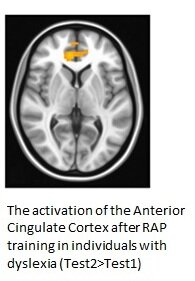The Error Detection Mechanism Among Dyslexic and Skilled Readers: Characterization and Plasticity
Tzipi Horowitz-Kraus Ph.D.
Reading, Writing, Mathematics and the Developing Brain: Listening to Many Voices, Literacy Studies Volume 6, 2012, pp 113-130
Abstract
The error detection mechanism, which is part of the human cognitive control system, is intended to prevent an error reoccurring. Its activation can be measured by the elicitation of two event-related potential components: error (ERN) and correct-related negativities (CRN). This chapter explores the evidence of the existence of this mechanism among dyslexics, despite their tendency to repeat reading errors. Because the mechanism is part of the brain’s learning circuitry, its ability to change naturally during development and following intervention programs aimed at improving dyslexics’ reading ability is also discussed.
© Springer Netherlands
Read Full Article
Can we turn individuals with dyslexia to typical readers using intervention programs?
In our previous studies we demonstrated how training with the reading acceleration program (RAP) in adults and children improves reading as well as increases the activation of the error detection circuitry of the brain. Does that mean the training with RAP helps readers with dyslexia to read like the typical reader or do these readers compensate for their reading difficulties using alternative neural paths? This question can be answered using non-invasive imaging tools such as magnetic resonance imaging (MRI). In a recent study we validated the increase in activation of the anterior cingulate cortex (which is the source for the error detection mechanism) following training with RAP (Figure 1). We also demonstrated how children with dyslexia show greater activation in the left hemisphere following intervention, tending to a more “typical” reading model. These preliminary results from our functional MRI strengthen the involvement of the error detection mechanism in the process of improved reading and suggest that RAP training affects individuals with dyslexia by focus their activation to the left side of the brain, as in typical readers. More study is necessary in order to identify the differences in connectivity between reading regions following RAP training in individuals with dyslexia as oppose to typical readers.







